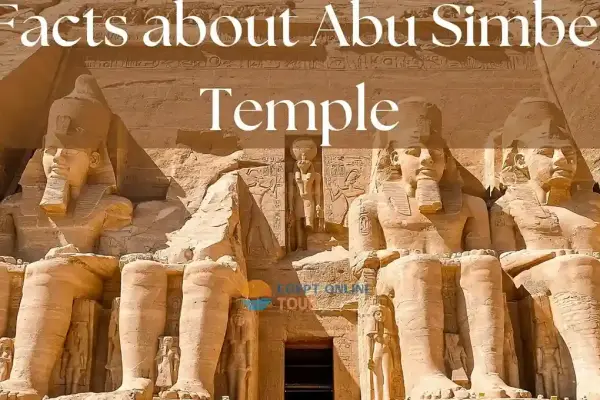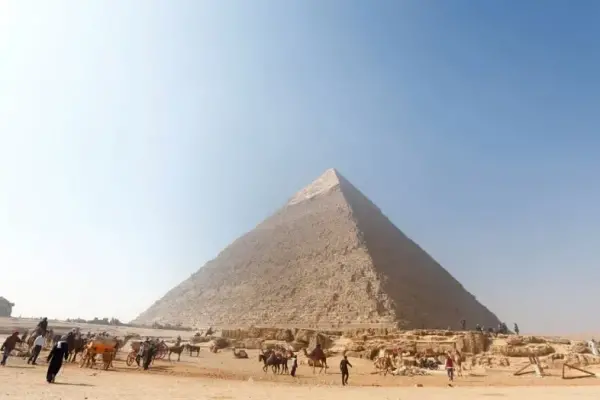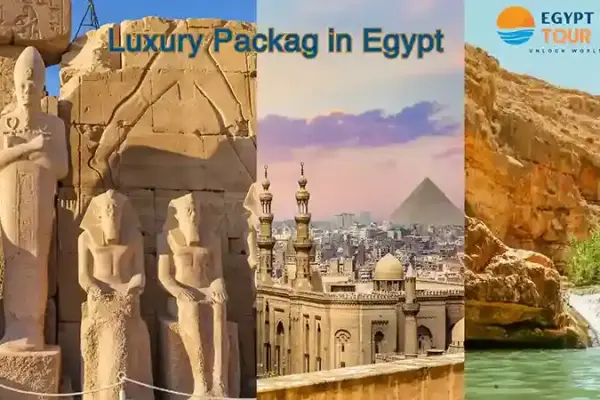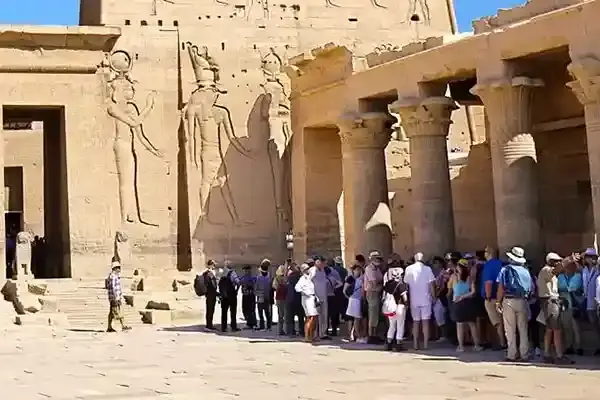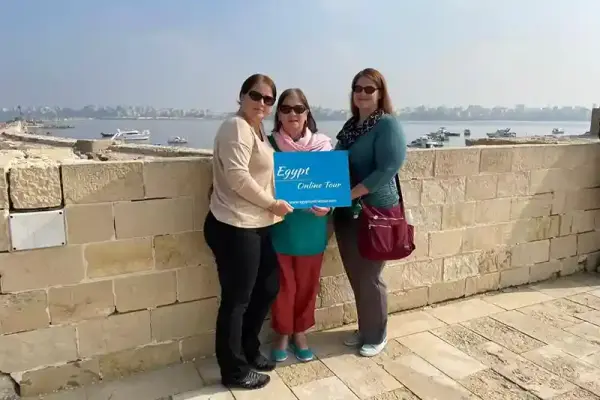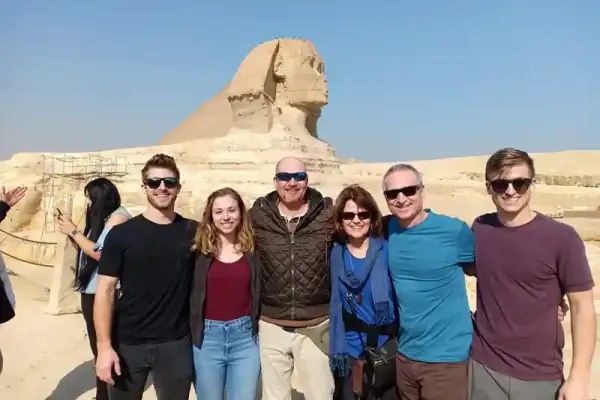Did you know that Abu Simbel Temple is not just an ancient architectural wonder but also a testament to the incredible genius of the ancient Egyptians in astronomy and engineering? Every year, hundreds gather to witness the rare Sun Festival, yet the big questions remain: Why was this temple built? And how was it moved piece by piece from its original location? If you're searching for facts about Abu Simbel temple, get ready to uncover some fascinating secrets about this iconic site.
Table of contents [Show]
- What is Abu Simbel in Egypt?
- Where is Abu Simbel located?
- Who built Abu Simbel?
- When was Abu Simbel built? How old is it?
-
Fascinating facts about Abu Simbel temples in Egypt
-
- 1- Construction
- 2- Purpose of the Abu Simbel Temples
- 3- The Abu Simbel Complex
- 4- Discovery of Abu Simbel
- 5- The Solar Phenomenon
- 6- Abu Simbel and Nefertari
- 7- Awe and Grandeur
- 8- Commemoration of the Battle of Kadesh
- 9- Relocation of the Temples
- 10- The World’s Largest Concrete Dome
- 11- Earthquake Resistance
- 12- The Sun and Abu Simbel
- 13- The Twin Temples
- 14- Rediscovery
- 15- Tourism at Abu Simbel
- Abu Simbel History: From Glory to Rescue
-
- Abu Simbel before relocation: What really happened?
- What is the Abu Simbel sun festival? A Fascinating blend of history and magic
- Why is Abu Simbel Temple in Egypt important?
- What is inside the Abu Simbel Temple?
- How to Visit Abu Simbel: A Complete Tourist Guide
- Abu Simbel Opening Hours
- When is the best time to visit Abu Simbel?
- How to Get to Abu Simbel
- Tours to Abu Simbel Temple
- Tips for Visiting Abu Simbel
- What Do People Eat at the Abu Simbel Festival?
What is Abu Simbel in Egypt?
Abu Simbel is one of Egypt's most fascinating ancient temples, tucked away in the far south, about 280 kilometers from Aswan, near the Sudanese border.
It was built by Pharaoh Ramses II in the 13th century BC, the temple grabs attention with its four giant statues of the king standing proudly at the entrance.
But what’s even more amazing is how the temple was designed to align perfectly with the sun — lighting up its inner sanctum twice a year in a stunning display of ancient Egyptian skill. For those seeking a blend of history and elegance, Egypt Luxury Tours offer an unforgettable journey to explore this masterpiece in style.
Why is Abu Simbel Temple so Special?
What makes Abu Simbel truly stand out isn’t just its size or design — it’s the incredible story of how it was saved. In the 1960s, when the Aswan High Dam threatened to flood the temple, a massive international effort took place to move it, piece by piece, to higher ground.
This wasn’t just about preserving a monument; it was about protecting a piece of history.
Today, Abu Simbel remains a powerful symbol of both ancient genius and modern determination, attracting visitors from around the world who come to experience its magic.
Where is Abu Simbel located?
Abu Simbel is tucked away in southern Egypt, about 280 kilometers southwest of Aswan, near the Sudanese border. It might feel a bit off the beaten path, but that’s part of its charm! The temple originally overlooked the Nile River, standing tall as a symbol of Pharaoh Ramses II’s power over Nubia.
Today, it rests along the shores of Lake Nasser, having been carefully moved in the 1960s to escape flooding caused by the Aswan High Dam. So, when you visit, you’re not just exploring an ancient site — you’re standing at a spot where history, geography, and a pretty incredible rescue mission all come together!
Who built Abu Simbel?
Abu Simbel was built by Pharaoh Ramses II, Who was one of ancient Egypt’s most powerful rulers, in the 13th century BC. It wasn’t just about showcasing his strength — the Great Temple was strategically placed at Egypt’s southern border to impress and assert his authority over Nubia. The entrance is guarded by four colossal statues of Ramses, each standing about 20 meters tall.
Right next to it, Ramses built the Small Temple for his beloved wife, Queen Nefertari — a rare gesture in ancient Egypt. What’s special is that Nefertari’s statues are almost as tall as Ramses’, symbolizing her unique status. Abu Simbel, therefore, isn’t just a political statement — it’s also a timeless blend of power and devotion, making it a site of both historical significance and heartfelt symbolism.
Read about: Did Thoth Built The Pyramids
When was Abu Simbel built? How old is it?
Abu Simbel was built during the reign of Pharaoh Ramses II, around 1264 BC, and took nearly 20 years to complete. That means the temple is now over 3,200 years old — imagine the stories and history it has witnessed over the centuries!
But what makes Abu Simbel special isn’t just its age. Ramses II didn’t build it randomly — it was a bold statement to celebrate his military victories, especially the Battle of Kadesh, and to showcase Egypt’s power along its southern borders.
Maybe like to read: When Was the Great Sphinx Built
Fascinating facts about Abu Simbel temples in Egypt
In a way, the temple wasn’t just a place of worship — it was a message to anyone approaching Egypt: this is a land of strength and greatness.
So, visiting Abu Simbel isn’t just about seeing ancient stones — it’s about stepping into a piece of history where art and politics were deeply connected. Here are some interesting facts about it:
1- Construction
The majestic Abu Simbel Temples were built by Pharaoh Ramses II, one of ancient Egypt’s greatest rulers. Construction began in Aswan, and the temples were carved directly into a solid granite cliff. The main goal was to immortalize Ramses II’s victory over the Hittites at the Battle of Kadesh in 1274 BC.
2- Purpose of the Abu Simbel Temples
The temples were dedicated to several ancient Egyptian gods, including Ra-Horakhty, Ptah, and Amun. Step into the world of Ramses II and explore the classic cities of Egypt — from Cairo to Abu Simbel, Luxor, and Aswan — in just 8 Days Cairo, Luxor, Aswan Classic Tours !
3- The Abu Simbel Complex
The Abu Simbel complex features two main temples:
- The Great Temple: Standing 30 meters high and 35 meters long, the entrance is adorned with four colossal statues of Ramses II seated in all his glory.
- The Small Temple: Built in honor of Queen Nefertari, Ramses II’s favorite wife, it lies 150 meters from the Great Temple. Its facade features six massive statues — four of Ramses and two of Nefertari.
You can sail through history with the Dahabiya Nile cruise , blending elegance and exploration across Egypt’s iconic sites.
4- Discovery of Abu Simbel
The Abu Simbel Temples were rediscovered in 1813 by Swiss explorer Johann Ludwig Burckhardt. Italian Egyptologist Giovanni Battista Belzoni later excavated the site in 1817.
Feel the magic of Abu Simbel up close with our 8 Days Cairo to Abu Simbel and Back Overland — a perfect journey through Egypt’s timeless wonders.
5- The Solar Phenomenon
A unique solar phenomenon occurs at Abu Simbel twice a year, known as the "Sun Festival." On February 22 and October 22 — believed to mark Ramses II’s birthday and coronation — the sun’s rays align perfectly to illuminate the inner sanctum, lighting up the statues of Ramses II, Amun, and Ra-Horakhty, while the statue of Ptah, the god of darkness, remains in shadow.
6- Abu Simbel and Nefertari
The Small Temple was dedicated to Queen Nefertari, symbolizing Ramses II’s deep affection and respect for his beloved wife.
7- Awe and Grandeur
The colossal statues and monumental design of the Great Temple were intended to inspire awe and strike fear into the hearts of Ramses II’s enemies.
8- Commemoration of the Battle of Kadesh
Abu Simbel honors Ramses II’s military triumph at the Battle of Kadesh — one of the most important battles in ancient Egyptian history.
9- Relocation of the Temples
When the construction of the Aswan High Dam threatened to submerge the temples, Egyptian sculptor Ahmed Osman proposed cutting the temples into massive blocks for relocation. In 1964, with UNESCO’s support, the temples were moved 200 meters from their original site, a project costing around $42 million, funded by donations from countries worldwide.
10- The World’s Largest Concrete Dome
Abu Simbel boasts the world’s largest concrete dome, measuring 65 meters in diameter and 23 meters in height, serving as a protective shield for the statues inside.
11- Earthquake Resistance
Engineered with incredible precision, Abu Simbel was built to withstand earthquakes up to a magnitude of 10 on the Richter scale without damage.
12- The Sun and Abu Simbel
The sun’s rays penetrate 200 meters into the Great Temple twice a year, illuminating the inner sanctum — a celestial event celebrated during the Sun Festival.
Sail through history on a 10 Days Round Trip Nile Cruise and Pyramids , visiting iconic landmarks like Abu Simbel and the Great Pyramids — a seamless blend of relaxation and exploration.
13- The Twin Temples
The complex consists of two temples — the Great Temple, dedicated to Ramses II and the gods Amun, Ra-Horakhty, and Ptah, and the Small Temple, dedicated to Queen Nefertari and the goddess Hathor.
14- Rediscovery
The Abu Simbel Temples were rediscovered in the 19th century by Swiss explorer Johann Burckhardt while he was exploring the region for the British African Association.
15- Tourism at Abu Simbel
Today, Abu Simbel remains one of Egypt’s top tourist attractions, drawing thousands of visitors each year.
Tourists can explore the intricate chambers and corridors, marvel at the statues and carvings, and visit the visitor center and museum to learn more about the temples’ history and restoration efforts. Discover the magic of Egypt tour packages that take you from the iconic pyramids to the majestic temples of Abu Simbel — a journey through history and wonder.
Read about: Strange Facts About The Pyramids
Abu Simbel History: From Glory to Rescue
Abu Simbel isn’t just an ancient temple — it’s like an open book carved in stone, telling stories of Egypt’s power and greatness. Built by Pharaoh Ramses II in the 13th century BC, the temple was a bold statement to celebrate his victories, especially the famous Battle of Kadesh against the Hittites — one of the oldest recorded battles in history.
The temple’s walls are filled with impressive carvings of Ramses riding his chariot and leading his army, sending a clear message to anyone approaching Egypt's borders: this is a land of strength and dominance.
But the story doesn’t end there! In the 1960s, the construction of the Aswan High Dam threatened to submerge Abu Simbel under the waters of Lake Nasser.
To save this historic treasure, a massive international rescue mission was launched. The temple was carefully dismantled and relocated 65 meters higher, a remarkable engineering achievement.
Today, Abu Simbel stands not just as a symbol of Ramses’ glory but also as a reminder of global efforts to preserve Egypt’s rich heritage.
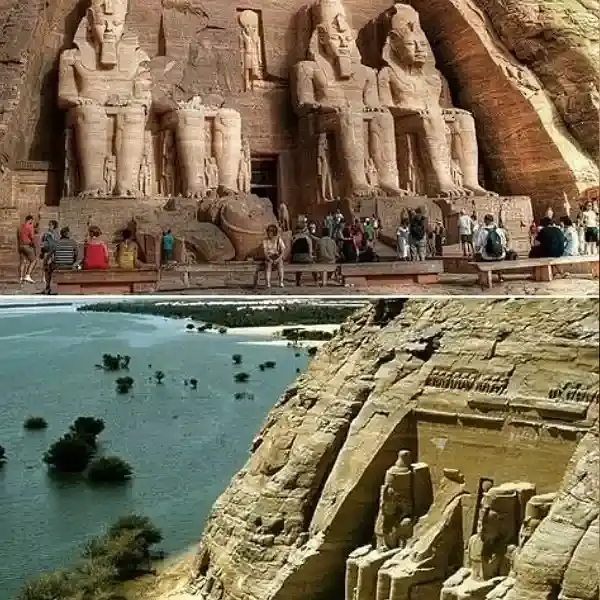
Abu Simbel before relocation: What really happened?
Imagine almost losing one of the world’s most stunning ancient temples to rising waters — that’s exactly what almost happened to Abu Simbel in the 1960s. When Egypt built the Aswan High Dam to control the Nile’s floods and generate electricity, the resulting Lake Nasser threatened to completely drown the temples of Abu Simbel.
But the world didn’t just stand by! UNESCO stepped in with a bold plan to save this priceless piece of history. An international team of experts worked together to cut the temples into over 1,000 massive blocks — each weighing up to 30 tons — and carefully moved them 65 meters higher to a safer location.
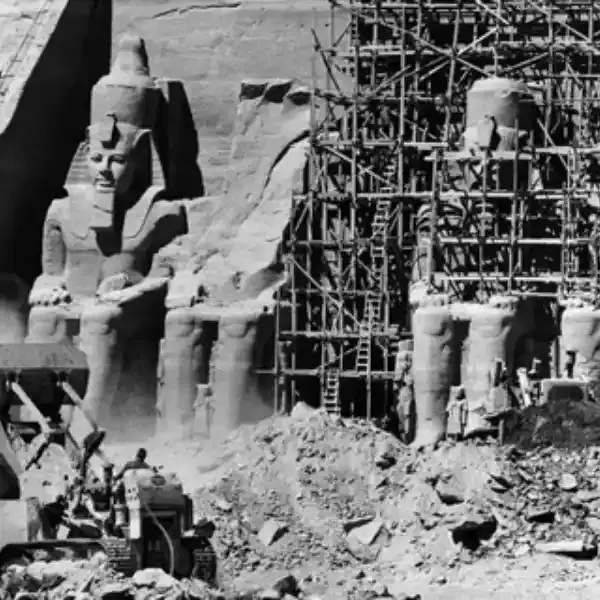
What happened at Abu Simbel? The amazing rescue story
Imagine moving a mountain — that’s pretty much what happened at Abu Simbel! Between 1964 and 1968, when the Aswan High Dam was built, the rising waters of Lake Nasser threatened to swallow the ancient temples. But instead of letting history sink, a massive global rescue mission led by UNESCO swung into action.
The temples were carefully cut into about 2,000 giant blocks, each weighing up to 30 tons — that’s like moving pieces of a massive stone puzzle! These blocks were then reassembled, piece by piece, 65 meters higher and 200 meters back from their original spot.
What’s even more impressive?
They reassembled everything so precisely that the famous Sun Festival, where the sun perfectly lights up the statues inside, still happens twice a year — just like it did thousands of years ago. This daring rescue wasn’t just about saving a temple; it was a powerful example of global teamwork to protect our shared history.
What is the Abu Simbel sun festival? A Fascinating blend of history and magic
Imagine standing in front of the grand Abu Simbel Temple at dawn, waiting for the sun to rise — and suddenly, its rays travel through the temple’s entrance, lighting up the inner sanctuary. This incredible event happens twice a year — on February 22nd and October 22nd — and is known as the Abu Simbel Sun Festival.
The sunlight reaches deep inside the temple, illuminating the statues of Ramses II and the gods Amun-Ra and Ra-Horakhty, while Ptah, the god of darkness, remains in the shadows — a stunning display of ancient Egyptian precision.
For those seeking even more celestial wonders, this magical experience is often paired with Egypt Eclipse Tour Packages , offering a rare blend of history and cosmic events.
Read about: What are the important holidays in Egypt
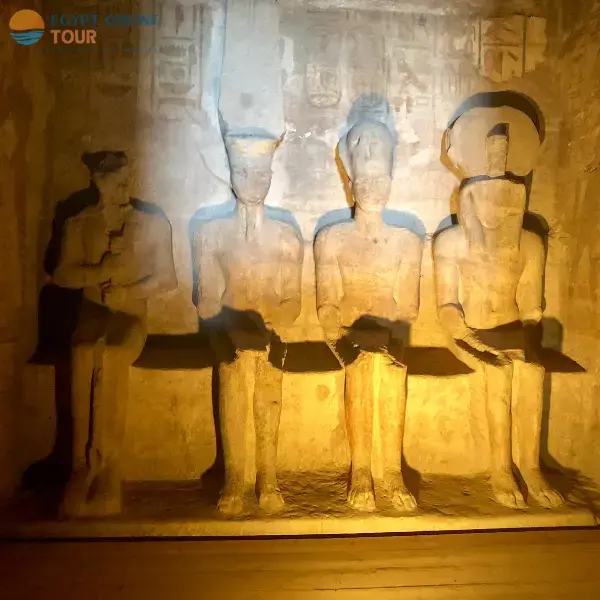
But why these specific dates?
Historians believe they mark two key moments in Ramses II's life: his birthday and the day he became king. This wasn’t a coincidence — the ancient Egyptians designed the temple to align perfectly with the sun on these days, showcasing their incredible knowledge of astronomy and architecture.
Today, the Sun Festival is more than just an ancient marvel. It draws thousands of visitors who gather to witness this rare phenomenon — a beautiful blend of history, science, and celebration.
If you ever plan to visit Abu Simbel, timing your trip with this festival will add an unforgettable experience to your journey!
Why is Abu Simbel Temple in Egypt important?
At first glance, Abu Simbel Temple might just seem like an impressive ancient monument, but there’s so much more to it! Beyond the giant statues and grand carvings, this temple tells a story of power, faith, and incredible scientific knowledge. So, why is it so important? Let’s break it down:
- A Symbol of Power: Built by Ramses II in the 13th century BC, the temple was a bold statement to show Egypt's strength and intimidate its enemies.
- Religious Significance: The temple wasn’t just about Ramses — it honored the gods Amun-Ra, Ra-Horakhty, and Ptah, blending his rule with divine authority.
- Astronomical Genius: The temple was carefully designed so that, twice a year, the sun's rays would light up the inner sanctuary, showcasing the ancient Egyptians' deep understanding of astronomy.
- Engine ering Marvel: The precise alignment and intricate carvings reflect the extraordinary architectural skills of ancient Egyptians.
Today, Abu Simbel isn’t just a reminder of Ramses II’s reign — it’s a living symbol of Egypt’s timeless greatness, blending history, science, and art in one majestic place.
What is inside the Abu Simbel Temple?
Walking into Abu Simbel Temple is like stepping back in time — a journey into the heart of ancient Egypt's wonders. While the colossal statues at the entrance grab your attention, the real magic unfolds inside. Let’s dive into what makes the temple’s interior so special:
The Grand Hall
Stepping inside Abu Simbel feels like traveling back in time. The Great Temple of Ramses II is a masterpiece of ancient Egyptian art and architecture.
As you walk through its massive entrance, you're greeted by a grand hall lined with colossal statues of Ramses II, each standing tall at over 10 meters.
The walls are covered with intricate carvings and colorful murals depicting the king’s military victories, especially the famous Battle of Kadesh.
The Inner Chambers
Go further, and you'll find smaller rooms thought to have been used for rituals and offerings. Every wall tells a story through hieroglyphics, capturing Ramses’ devotion to the gods and his military victories.
The Holy of Holies
Venture deeper, and you'll find the most sacred part of the temple — the Sanctuary (Holy of Holies) — where four statues sit side by side: Ramses II and the gods Amun, Ra-Horakhty, and Ptah.
What’s fascinating is that twice a year, on February 22nd and October 22nd, sunlight pierces through the temple, illuminating three of the statues — except Ptah, the god of darkness, who remains in shadow.
Temple of Nefertari
Next to the Great Temple is the Temple of Nefertari, dedicated to Ramses’ beloved queen and the goddess Hathor.
Unlike other temples where queens were portrayed much smaller than kings, Nefertari’s statues stand almost as tall as Ramses’, symbolizing her significance.
Inside, the walls are beautifully decorated with scenes of Nefertari making offerings to the gods, emphasizing her divine status.
In short, inside Abu Simbel, you'll find:
- The Grand Hall with massive Ramses II statues.
- The Inner Chambers, murals and carvings showcasing military victories.
- The Sanctuary (Holy of Holies) with four iconic statues.
- The Temple of Nefertari with life-sized stat ues and vibrant artwork.
It’s not just a collection of stone and symbols — it’s a breathtaking story of power, love, and faith carved into rock. Explore the heart of ancient Egypt —through our 10 Days Cairo, Aswan, Luxor & Hurghada Overland Tour from the majestic temples of Abu Simbel to the serene beauty of Aswan and Luxor, all in a 10-day unforgettable tour.
Read: Can You Go Inside The Great Pyramids
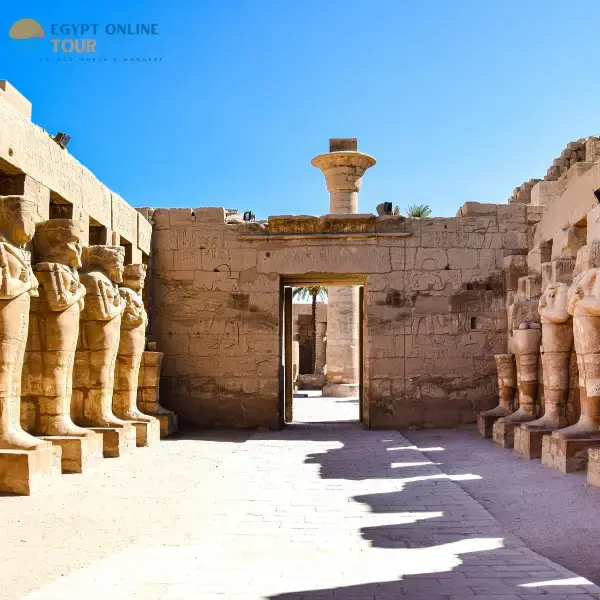
How to Visit Abu Simbel: A Complete Tourist Guide
Visiting Abu Simbel is an unforgettable journey back in time, allowing you to explore the grandeur of the pharaohs and the brilliance of ancient Egyptian civilization. If you're planning a trip to this iconic site, here’s a simple and friendly guide to help you make the most of your visit.
Abu Simbel Opening Hours
Abu Simbel Temple is open daily from 5 AM to 6 PM. Ticket prices are as follows:
- Egyptians and Arabs: 20 EGP
- Foreig ners: 260 EGP
It’s best to visit early in the morning to avoid crowds and enjoy a more peaceful atmosphere.
When is the best time to visit Abu Simbel?
For a truly special experience, plan your visit during the “Sun Festival” — a stunning solar alignment that happens twice a year, on “October 22nd and February 22nd”. During this event, the sun’s rays illuminate the sanctuary and light up the faces of the four statues, except for the statue of the god Ptah, who symbolizes darkness.
If you prefer a quieter visit, the period between “November and February” is ideal, offering pleasant weather and fewer tourists.
Read: Cheapest Time to Go to Egypt
How to Get to Abu Simbel
There are several ways to reach the temple:
- By Plane: A quick 45-minute flight from Aswan to Abu Simbel Airport.
- By Bus: A more affordable option — the bus ride from Aswan takes around 3 to 4 hours.
- By Nile Cruise: For tho se seeking luxury, opt for a Nile cruise that combines relaxation and exploration.
Tours to Abu Simbel Temple
Consider joining organized tours, such as:
- Day Trips from Aswan: include round-trip transportation, a tour guide, and entrance fees.
- Nile Crui se Excursions: Offering a unique experience with comfortable accommodation and guided tours.
- Read about: How Much Does It Cost to Go to Egypt
Tips for Visiting Abu Simbel
Visiting Abu Simbel Temple is an unforgettable experience that takes you on a journey through time, uncovering the greatness of the pharaohs and the beauty of ancient Egyptian civilization.
If you're planning a trip to this stunning site, here’s a simple and friendly guide to help you make the most of your visit:
- Clothing: Wear light, comfortable clothes, along with a hat and sunglasses.
- Timing: Arrive early to beat the crowds.
- Food and Water: Bring a bottle of water and some light snacks.
- Camera: Don’t forg et your camera to capture unforgettable moments.
In short, visiting Abu Simbel isn’t just a sightseeing trip — it’s a gateway to the wonders of ancient Egypt. Plan ahead, soak in the history, and cherish every moment at this awe-inspiring site!
What Do People Eat at the Abu Simbel Festival?
The Abu Simbel Festival isn't just about witnessing the incredible solar alignment; it’s also a celebration of Egyptian culture and heritage — and food plays a big part in it! During the festival, you can enjoy a variety of traditional dishes, such as:
- Feteer Meshaltet: A layered pastry symbolizing rural generosity, often served with black honey or cheese.
- Taameya and Ful: Classic Egyptian breakfast staples made from fava beans and falafel, offering a taste of local life.
- Koshari: A hearty mix of rice, pasta, lentils, and fried onions — a true Egyptian comfort food.
- Dates an d Nuts: Popular snacks shared during gatherings and celebrations.
These dishes connect the past with the present, as many have roots in ancient Egyptian cuisine. It’s a unique way for visitors to not only witness history but also savor the flavors of Egypt’s rich cultural tapestry
FQAs
Who paid to move Abu Simbel?
After the construction of the Aswan High Dam, the submerged ruins surfaced. In the 1970s, the Egyptian government, with UNESCO's support, relocated Abu Simbel by dismantling its statues and chambers and reassembling them on higher ground to preserve the site.
How long did it take to save Abu Simbel?
Abu Simbel was reopened at its new location on September 22, 1968. The Philae monuments, the last to be relocated, were moved to Agilkia Island between 1972 and 1979. These efforts set a new benchmark for balancing modern development with heritage preservation.
How much did it cost to move Abu Simbel?
Moving the Abu Simbel temples involved cutting them into blocks and relocating them 210 meters back and 65 meters higher to avoid flooding. The cost was $40 million at the time, equivalent to $388 million today.
How old is the Abu Simbel Temple?
The construction of Abu Simbel began around 1264 BC and took about 20 years, finishing in 1244 BC. It was originally known as the Temple of Ramesses, Beloved by Amun.
Popular Categories
Related tours
Cairo, Aswan, and Luxor
-
Starting From
$ 2,850
-
Type
Package
Cairo, Aswan, and Luxor
-
Starting From
$ 5,900
-
Type
Package
Cairo, Aswan, and Luxor
-
Starting From
$ 1,600
-
Type
Package
Cairo, Aswan, and Luxor
-
Starting From
$ 1,850
-
Type
Package
